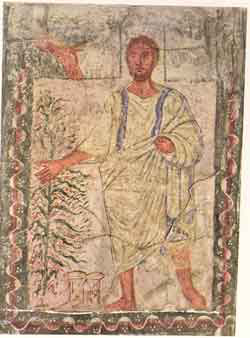In his book, The Art of Biblical Narrative, Robert Alter defines a convention in biblical story-telling that he calls “type scenes”. These are recurring vignettes dealing with significant events and conforming to a set structure, but with different characters. One of these type scenes is the meeting at the well that leads to betrothal. Today we would say boy meets girl. There are three examples of this scene in the Bible: the betrothal of Rebecca - Genesis 24; the meeting of Jacob and Rachel - Genesis 29; the meeting of Moses and Zipporah - Exodus 2. Alter identifies a pattern of events in each story: a lone traveler arrives in a foreign destination, at the local well he encounters a maiden, water is drawn either by her or by him, she runs home to report the coming of the stranger, a festive meal celebrates the betrothal of the couple. Along with the standard pattern, there are also significant variations in the details
The betrothal of Rebecca
Let’s start with the first, most detailed and perhaps the most far-reaching example, despite the puzzling absence of the groom, Isaac. First, the patriarch, Abraham, lays out specific instructions to his servant regarding the quest for Isaac’s bride, pointedly forbidding him to take a Canaanite wife.
(ג) וְאַשְׁבִּ֣יעֲךָ֔ בַּֽיהוה אֱלֹהֵ֣י הַשָּׁמַ֔יִם וֵֽאלֹהֵ֖י הָאָ֑רֶץ אֲשֶׁ֨ר לֹֽא־תִקַּ֤ח אִשָּׁה֙ לִבְנִ֔י מִבְּנוֹת֙ הַֽכְּנַעֲנִ֔י אֲשֶׁ֥ר אָנֹכִ֖י יוֹשֵׁ֥ב בְּקִרְבּֽוֹ׃ (ד) כִּ֧י אֶל־אַרְצִ֛י וְאֶל־מוֹלַדְתִּ֖י תֵּלֵ֑ךְ וְלָקַחְתָּ֥ אִשָּׁ֖ה לִבְנִ֥י לְיִצְחָֽק׃
(3) and I will make you swear by יהוה, the God of heaven and the God of the earth, that you will not take a wife for my son from the daughters of the Canaanites among whom I dwell, (4) but will go to the land of my birth and get a wife for my son Isaac.”
Abraham assures the servant that God will guarantee the success of the mission, adding that if the chosen woman declines to come, the servant will be free of his commission.
The servant arrives and prays:
(יב) וַיֹּאמַ֓ר ׀ יְהֹוָ֗ה אֱלֹהֵי֙ אֲדֹנִ֣י אַבְרָהָ֔ם הַקְרֵה־נָ֥א לְפָנַ֖י הַיּ֑וֹם וַעֲשֵׂה־חֶ֕סֶד עִ֖ם אֲדֹנִ֥י אַבְרָהָֽם׃ (יג) הִנֵּ֛ה אָנֹכִ֥י נִצָּ֖ב עַל־עֵ֣ין הַמָּ֑יִם וּבְנוֹת֙ אַנְשֵׁ֣י הָעִ֔יר יֹצְאֹ֖ת לִשְׁאֹ֥ב מָֽיִם׃ (יד) וְהָיָ֣ה הַֽנַּעֲרָ֗ אֲשֶׁ֨ר אֹמַ֤ר אֵלֶ֙יהָ֙ הַטִּי־נָ֤א כַדֵּךְ֙ וְאֶשְׁתֶּ֔ה וְאָמְרָ֣ה שְׁתֵ֔ה וְגַם־גְּמַלֶּ֖יךָ אַשְׁקֶ֑ה אֹתָ֤הּ הֹכַ֙חְתָּ֙ לְעַבְדְּךָ֣ לְיִצְחָ֔ק וּבָ֣הּ אֵדַ֔ע כִּי־עָשִׂ֥יתָ חֶ֖סֶד עִם־אֲדֹנִֽי׃
(12) And he said, “O יהוה, God of my master Abraham’s [house], grant me good fortune this day, and deal graciously with my master Abraham: (13) Here I stand by the spring as the daughters of the townspeople come out to draw water; (14) let the maiden to whom I say, ‘Please, lower your jar that I may drink,’ and who replies, ‘Drink, and I will also water your camels’—let her be the one whom You have decreed for Your servant Isaac. Thereby shall I know that You have dealt graciously with my master.”
Lo and behold Rebecca - the granddaughter of one of Abraham’s brother, Haran, and the niece of another brother, Nahor - appears and fulfills the prayer. It should be noted that only in Genesis 24 is it the woman who does the watering. The female nourishing of the male enhances the matriarchal role in this iteration of the type scene. Abraham’s servant is merely a medium for the Divine will and therefore it is especially fitting that she perform the symbolic act.
Rebecca is the ideal mate for Isaac, because together they unite all the branches of the Terahite clan that will climax with Jacob = Israel.
She runs home laden with gifts to tell “her mother’s house” about the encounter. Her brother Laban invites the servant to stay with them. The servant proceeds to recount his commission and its fulfillment; the family agrees to the match and as an afterthought, Rebecca is consulted and agrees to go to Canaan. It is only when they reach Canaan that she meets and marries Isaac.
In the account, the servant dominates both action and speech, whereas in the art, as we shall now see, Rebecca takes center stage. In fact, women star in much of the artwork on this story. Possibly, this is because Rebecca, alone among the Matriarchs, is designated a virgin and therefore prefigures the Virgin Mary in Christian interpretation.
We are going to discuss four works of art dealing with Rebecca at the well, ranging from the seventh to the twentieth century. Our first example is the Vienna Genesis, which portrays the scene in three separate pictures.
Apparently produced in Syria in the seventh century, the manuscript was painted on calf skin which gives it an unusual pinkish tone. Originally it comprised approximately ninety-six folios, most of which were lost over the years. Just part of our story (Genesis 24: 1 - 31) is detailed within three separate folios of the remaining twenty-four, indicating the special importance of the account.
In the first folio, Abraham commissions the servant, who travels with the camels, arriving at the well outside Harran.
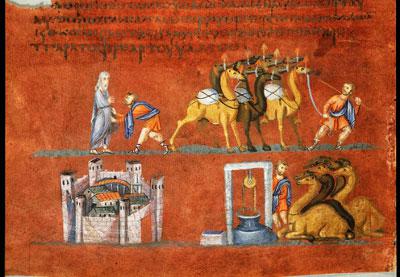
In the second folio, the servant encounters Rebecca.
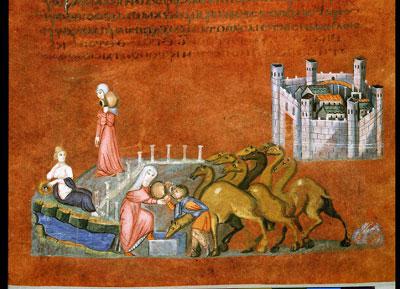
She appears twice, first approaching the well, a strong erect figure, and a second time, pouring water into the servant’s mouth, as in a majority of the artwork on this scene. A female figure is seated at the left-hand corner of the well - a naiad, the spirit of the spring. In a narrative emphasizing the role of women, this sprite represents the divine role in female fertility.
In the third folio, the sprite appears again behind Rebecca, who is receiving gifts from the servant.
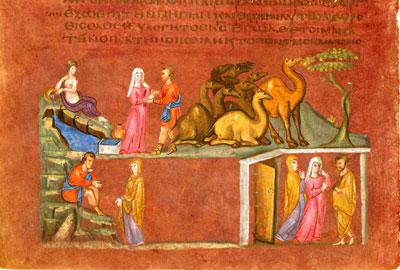
In the lower register, on the right, Rebecca stands inside a house, speaking with a man and a woman; and on the left, that woman meets the servant, still seated by the well.
Four elements in the Vienna Genesis raise questions:
- Why would a Christian document feature a pagan water spirit?
- Who is the woman inside the house with Rebecca and Laban?
- Why is it this woman who greets the servant, rather than Laban, as in the text?
- How can we account for the divergences in the Vienna Genesis from the biblical text, which it quotes at length above the pictures?
With regard to the sprite, she seems at first to be merely a convention of Hellenistic-Roman art. In fact, the addition of this female figure further highlights the importance of women in Rebecca’s betrothal scene in the Vienna Genesis.
With regard to the woman in the house, art historians maintain that she is Rebecca’s mother (although this woman is never named nor does she have a significant role in the biblical text). Perhaps this figure represents “her mother’s house” (see above, Genesis 24:28).
Concerning the woman who replaces Laban as the greeter of Abraham’s servant, some scholars hypothesize an unknown apocryphal retelling of the story. We suggest that this is yet another example of the highlighting of women in the Vienna Genesis.
As mentioned above, Rebecca is seen in Christian commentary as the model of the Virgin Mary. Therefore, the artist of the Vienna Genesis enriched the biblical story by stressing Rebecca’s role and adding female characters.
Regarding the divergences of the pictures in the Vienna Genesis from the biblical account, it seems quite clear that in many cases, the pictures are based on literary midrashim (Jewish and Christian) or that they themselves are visual midrashim created by the artist(s) of the Vienna Genesis. This phenomenon can be compared with the paraphrasing of biblical stories found in Josephus' Antiquities of the Jews. In both cases, the ancient stories were re-imagined in accordance with the realia and the beliefs of the period in which they were read: the Roman-Byzantine age.
In the cycle of mosaics in the 12th century monastery of Monreale in Sicily, two parts of our chapter are illustrated: the watering scene and the travel to Canaan.

Monreale, 1180s
In most depictions of Genesis 24, Rebecca is pouring water directly into the mouth of the servant. In a departure from this norm, here Rebecca is watering the camels, rather than the servant. It appears that Monreale and some other treatments avoid such intimacy as unbecoming for the model of the Virgin.
An additional departure is the picturing of the return journey: we have no other example of this scene in art. We might have expected a portrayal of the meeting between Rebecca and Isaac. Again, Rebecca’s journey avoids any intimacy with a male. She is traveling home with three men, but without any physical contact.
It should be further noted that Rebecca appears three more times in the Monreale mosaics, in the theft of the blessing (Genesis 28). Once again, she stars because of the Christian typology as the Virgin Mary.
As opposed to most of the art on this scene, Renaissance painter Paolo Veronese and neo-classical Benjamin West focus not on the watering of the servant and the camels by Rebecca, but on the giving of gifts, thereby shifting the point of the scene. It is the reward for hospitality to a stranger (a wide-spread motif in folklore) that interests these painters, rather than the hospitality itself. Is this an effect of the renewed interest in classical literature during the Renaissance?

Notice that Veronese adds two male figures in addition to Rebecca and Abraham’s servant, while West includes two young women. This inclusion by West may be based on Josephus, where Rebecca is the only one of several girls offering water to the stranger. Thus, Rebecca’s generosity is further heightened.
The main subject of a painting by Moshe Shah Mizrahi from the early 20th century is the binding of Isaac.
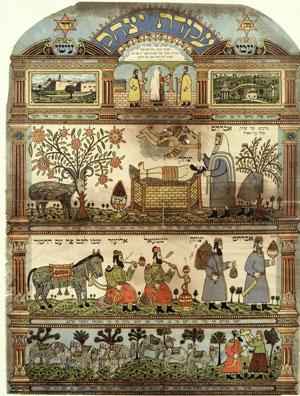
At the bottom of the painting, an entire register portrays the meeting at the well between Rebecca and Abraham’s servant.

As usual, she is pouring water from a jug into the servant’s mouth. Why should this scene be included in a painting of the Akedah?
The story of Rebecca’s betrothal is separated from the Akedah by an entire chapter and Isaac only appears marginally in Genesis 24. But it is in Genesis 24 that the patriarchal line, which could have ended at Moriah, is ensured. Therefore, it is a fitting and necessary continuation of the Akedah.
Mizrahi’s inclusion of Genesis 24 in his painting of the akedah also helps to explain why Isaac himself was not sent to find his bride. In the folk motif, the stranger who asks for water is usually a disguised god or his representative. Abraham’s servant is told that God will accompany him and he (the servant) asks God to “deal graciously with [Abraham]” by causing a girl to offer him water. Thus, while God does not figure openly in Genesis 24, He is working behind the scenes and particularly through Abraham’s servant. This is not the story of a young man seeking (or coincidentally finding) a bride, but of God intervening in human affairs to achieve His desired end.
Jacob and Rachel
The next meeting by the well takes place in Genesis 29. Jacob, directed by his mother, has fled from his home, heading for her family back in Harran. On arrival he finds shepherds with their flocks, waiting for all to gather in order to move the heavy stone that covers the mouth of the local well.
(ט) עוֹדֶ֖נּוּ מְדַבֵּ֣ר עִמָּ֑ם וְרָחֵ֣ל ׀ בָּ֗אָה עִם־הַצֹּאן֙ אֲשֶׁ֣ר לְאָבִ֔יהָ כִּ֥י רֹעָ֖ה הִֽוא׃ (י) וַיְהִ֡י כַּאֲשֶׁר֩ רָאָ֨ה יַעֲקֹ֜ב אֶת־רָחֵ֗ל בַּת־לָבָן֙ אֲחִ֣י אִמּ֔וֹ וְאֶת־צֹ֥אן לָבָ֖ן אֲחִ֣י אִמּ֑וֹ וַיִּגַּ֣שׁ יַעֲקֹ֗ב וַיָּ֤גֶל אֶת־הָאֶ֙בֶן֙ מֵעַל֙ פִּ֣י הַבְּאֵ֔ר וַיַּ֕שְׁקְ אֶת־צֹ֥אן לָבָ֖ן אֲחִ֥י אִמּֽוֹ׃ (יא) וַיִּשַּׁ֥ק יַעֲקֹ֖ב לְרָחֵ֑ל וַיִּשָּׂ֥א אֶת־קֹל֖וֹ וַיֵּֽבְךְּ׃ (יב) וַיַּגֵּ֨ד יַעֲקֹ֜ב לְרָחֵ֗ל כִּ֣י אֲחִ֤י אָבִ֙יהָ֙ ה֔וּא וְכִ֥י בֶן־רִבְקָ֖ה ה֑וּא וַתָּ֖רׇץ וַתַּגֵּ֥ד לְאָבִֽיהָ׃ (יג) וַיְהִי֩ כִשְׁמֹ֨עַ לָבָ֜ן אֶת־שֵׁ֣מַע ׀ יַעֲקֹ֣ב בֶּן־אֲחֹת֗וֹ וַיָּ֤רׇץ לִקְרָאתוֹ֙ וַיְחַבֶּק־לוֹ֙ וַיְנַשֶּׁק־ל֔וֹ וַיְבִיאֵ֖הוּ אֶל־בֵּית֑וֹ וַיְסַפֵּ֣ר לְלָבָ֔ן אֵ֥ת כׇּל־הַדְּבָרִ֖ים הָאֵֽלֶּה׃ (יד) וַיֹּ֤אמֶר לוֹ֙ לָבָ֔ן אַ֛ךְ עַצְמִ֥י וּבְשָׂרִ֖י אָ֑תָּה וַיֵּ֥שֶׁב עִמּ֖וֹ חֹ֥דֶשׁ יָמִֽים׃
(9) While he was still speaking with them, Rachel came with her father’s flock—for she was its shepherd. (10) And when Jacob saw Rachel, the daughter of his uncle Laban, and the flock of his uncle Laban, Jacob went up and rolled the stone off the mouth of the well, and watered the flock of his uncle Laban. (11) Then Jacob kissed Rachel, and broke into tears. (12) Jacob told Rachel that he was her father’s kinsman, that he was Rebekah’s son; and she ran and told her father. (13) On hearing the news of his sister’s son Jacob, Laban ran to greet him; he embraced him and kissed him, and took him into his house. He told Laban all that had happened, (14) and Laban said to him, “You are truly my bone and flesh.” When he had stayed with him a month’s time,
In a 13th century Book of Hours, one page depicts a series of scenes starting with the theft of Esau's blessing. It contains a puzzling take on the story of Jacob and Rachel, diverging repeatedly from the text.
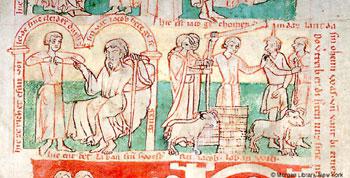
On the right side of the first picture relating to our story, Rachel and Leah stand next to Jacob who is threatening the shepherds. For some reason, one of the shepherds is wearing a Jews’ hat (see below). In addition, Leah does not actually appear in this part of the biblical account.
In the second picture, three women are pointing to the embracing pair of Jacob and Laban: The two sisters from one side and a mysterious woman who stands under an arch on the other side. The mystery woman is identified in the manuscript as Laban’s wife, who has no presence in the text.
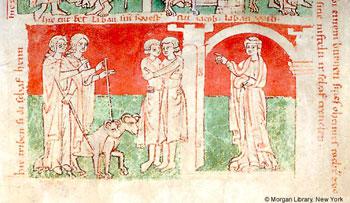
These changes from the biblical text raise questions: 1) why is Jacob at odds with the shepherds? 2) why does Leah accompany Rachel and 3) why does Laban’s wife suddenly appear?
With regard to Jacob’s hostility, two explanations can be offered: 1) Jacob at the well has been conflated with Moses at the well, who drives away the shepherds and 2) since Jacob is seen as a type of Jesus in Christian commentary, he is hostile to the “Jewish” shepherds.
With regard to the female figures, we also offer two suggestions: 1) as in the art on Rebecca’s betrothal, the biblical matriarchs assume a heightened importance because they prefigure the Virgin Mary, and 2) the labeling of the enigmatic female figure as Laban’s wife is a mistaken identity - she is in fact Rebecca, the classic manipulator, directing action from afar.
Soon after the Book of Hours, Jacob and Rachel’s well scene appears in the Morgan Bible.
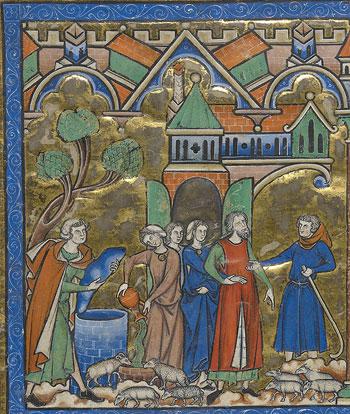
This painting stages two events, separated in time by about a month. On the left, the traveler meets the bride to be, removes the stone from the mouth of the well while, contrary to the text, the bride waters her flocks. This divergence from the text may be due to a conflation of the Jacob-Rachel story with the story of Rebecca. On the right, Jacob, now in shepherds’ clothing, asks for the hand of Rachel. The position of hands tells two stories: 1) Laban’s enthusiastic approval of the match and 2) the job offer to his future son-in-law. The older sister, in the background and unmentioned in the text, foreshadows the deception that will take place, when Leah is substituted for Rachel on the bridal night.
Five centuries later, the story is portrayed naturalistically and romantically by William Dyce.

The flocks and the city in the background set the scene. An insistent lover, overcome with emotion, Jacob presses Rachel’s right hand close to his heart. His left arm, embracing her shoulder, brings them close together. She looks downward modestly and leaning back, supporting herself on the well. Dyce sees the scene as electric with anticipation.
Some 50 years later, James Tissot finds nothing romantic in the scene. Jacob’s heroic effort to lift the stone goes unappreciated by the haughty Rachel, who stands regally amidst the cacophanous flocks.
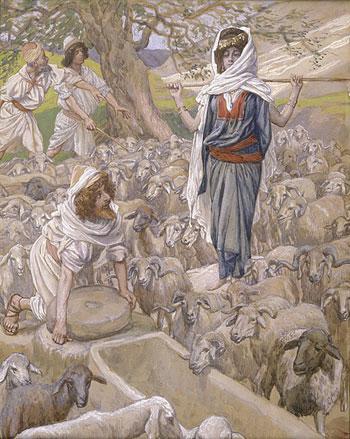
Artistic treatment of the meeting between Rachel and Jacob has, then, gone through radical transformations, from a prefiguring of the Virgin Mary to a somewhat comedic meeting at the trough.
Moses and Zipporah
Our final well scene involves Moses and Zipporah, daughter of the priest of Midian. After killing an Egyptian overseer who was beating “a Hebrew, of his brothers”, Moses has fled Egypt and finds a resting place at “the well” in Midian. He encounters a group of girls coming to water their flocks, who are being hassled by a rough gang of shepherds. Moses, the future redeemer of the people of Israel, continues to defend the oppressed and drives the shepherds away and then waters the girls’ flocks. Returning home, earlier than usual, they tell the story of the “Egyptian” who “saved” them. Reuel, their father, gratefully invites Moses to his home and offers his daughter Zipporah in marriage to the worthy stranger.
Framed between two towering trees and head and shoulders above the others, Moses is central in the 14th century Golden Haggadah.
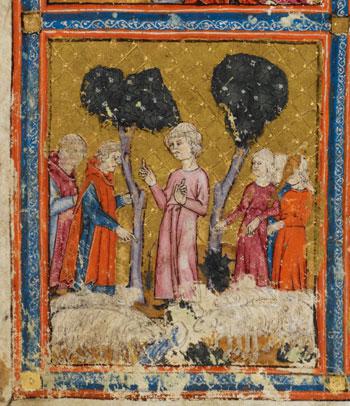
The Golden Haggadah, ca. 1320
His contorted fingers gesture antagonism, as does his face. Behind him, stand Reuel’s daughters looking helpless. Opposite Moses are two hostile shepherds. With his own body as a barrier between the two groups, he defends the weak.
In a contemporary Bible Moralisee, the story is presented literally in the upper register and also allegorized below.
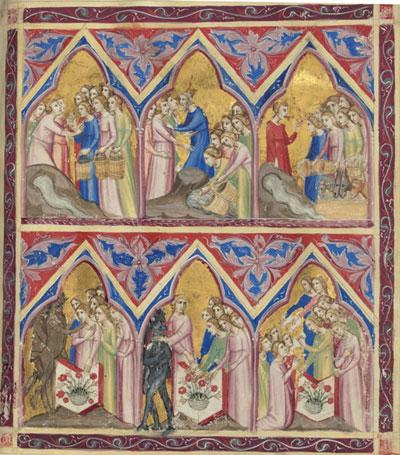
In the upper register, the literal tale unfolds. The shepherds lay hands on the girls; Moses pushes the shepherds away, while the girls water the flock (contrary to the biblical account); and finally, they recount the event to Reuel.
In the lower register, the daughters of Reuel signify the seven virtues, the shepherds are devils and Moses is Jesus. The well becomes the font of divinity in this Christian allegory, as in many Jewish midrashim. The flocks are the faithful, now able to drink from the waters of life.
Moving ahead in time, we find a new interest in the drama of the meeting at the well.
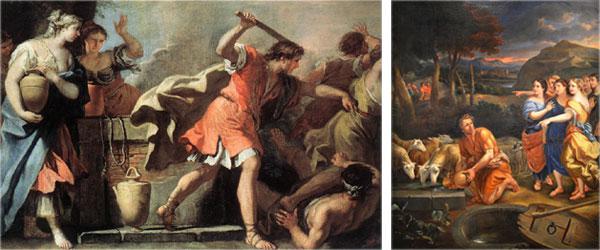
ca. 1720 after 1838
Late baroque Venetian artist, Sebastiano Ricci, paints a stormy pursuit. Central and dynamic, Moses fells one shepherd and while driving away the others. Admiring women, bearing jars cheer the hero and curse the ruffians.
The turbulent scene quiets in the work of Canadian artist, Theophile Hamel. Moses, again central, having routed the fleeing shepherds, kneels to water the flocks. The seven daughters of Reuel point in admiration.
Despite the obvious differences between these two almost modern paintings, both center on Moses the hero, saving and caring for the “damsels in distress”.
Our concluding image is a universe apart. The Islamic version of the Exodus well scene is found in the Quran, in later Muslim traditions and in Muslim art.
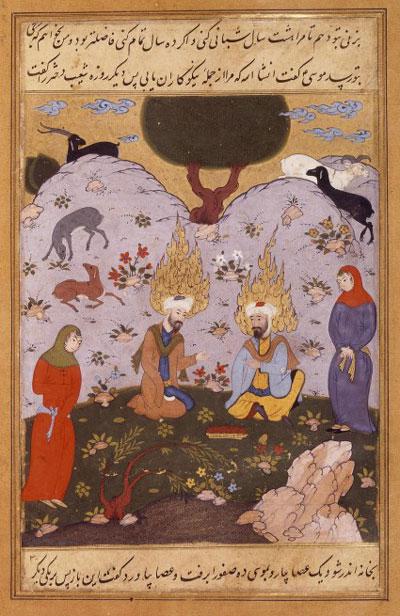
In this late 16th century illuminated manuscript of the Stories of Prophets by Nisaburi, we confront a totally different visual language. Moses and Shueib (=Reuel, the priest of Midian) are seated, while Shueib’s two daughters (rather than the seven in Exodus) stand on either side. This reduction may be a conflation with the story of Jacob and Laban’s two daughters. The well itself does not appear in Muslim art, which focuses only on the betrothal negotiation after the meeting.
Muslim tradition differs from the Bible and western art in that Moses is the scion of the Hebrew prophets, while Shueib is the scion of the Arabic prophets. Moses’ marriage to Zipporah therefore is the union of these two branches of pre-Islamic prophecy. This is similar to the union of the families of Terah in Genesis, achieved by the marriage of Isaac and Rebecca.
The meeting at the well, which leads to a betrothal is, according to Alter, a standard and expected part of the story of the biblical hero. He claims that it conforms to a particular structure and that divergences from this structure are just as significant as the structure itself. In examining the biblical stories, we can already see that that the convention is used for various purposes. Genesis 24 stresses the role of the agent (Abraham’s servant) and of Rebecca, while Isaac is entirely missing; the point of the story is the (re)union of the parts of the now far-flung family of Terah, through the guiding but unseen hand of God; only here it is the bride-to-be who draws water, stressing the feminine role in this reunion. Genesis 29 focuses on Jacob, the trickster who has left his own family under duress and is so moved by his encounter with his kinswoman Rachel, that he moves a gigantic stone by himself, kisses and embraces his intended and weeps; the story is indeed a turning point in the character formation of the hero. And finally, Exodus 2 stresses Moses’ heroism in aiding the entirely foreign damsels in distress, showing him as the destined savior of the oppressed people of Israel.
The artists who have treated these three stories have, of course, brought with them their own readings of the biblical stories and sometimes diverged radically from the “original” intention of the Bible, making the stories their own.



